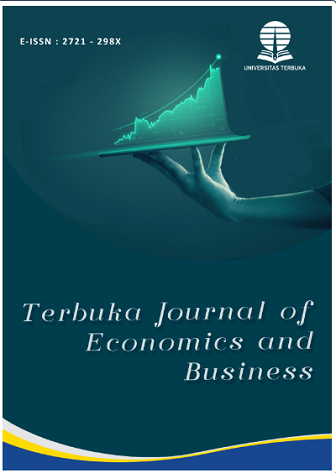Increasing Value Added Tax (VAT) 12% and Impact on The Economy Society: Systematic Literature Study Approach
Keywords:
VAT, Indoensian Economy, Systematic Literature Review, InflationAbstract
The increase in the Value Added Tax (VAT) rate from 11% to 12% is one of the strategic policies of the Indonesian government to increase state revenues to support sustainable development. This policy is regulated in the Law on Harmonization of Tax Regulations (UU HPP) and aims to expand the tax base and create fiscal justice. This study aims to analyze the impact of the increase in VAT rates on the Indonesian economy using a qualitative method based on a systematic literature review. Data were analyzed from various scientific articles, online news, and related policy reports to provide a comprehensive picture of the implications of this policy. The results of the study show that the increase in VAT rates has a direct contribution to increasing state revenues, which is expected to support the development of infrastructure, education, and health. However, this policy has also raised concerns about the additional burden on people's purchasing power, especially low-income groups, although basic necessities are not included in the scope of VAT. In addition, the analysis shows that this rate increase contributed additional inflation of around 0.2% in the first year of its implementation, which is temporary because it is limited to the initial adjustment phase. Inflation in Indonesia tends to be more influenced by global commodity prices than changes in VAT rates, so its impact on economic growth is projected to be minimal. The long-term success of this policy depends heavily on effective management of state revenues and government transparency in communicating the benefits of the policy to the public. Thus, this VAT rate increase can be an effective tool to support sustainable development if supported by adequate supporting policies.
References
Agasie, D., & Zubaedah, R. (2022). Urgensi Kenaikan Tarif Pajak Pertambahan Nilai Berdasarkan Asas Kepentingan Nasional. Perspektif Hukum, 50–74. https://doi.org/10.30649/ph.v22i2.131
Dwi Septiani, F. (2023). Krisis Keuangan Dan Transformasi Kebijakan Apbn: Tantangan Dan Strategi Khusus Pada Pajak Penghasilan (Pph) Dan Pajak Pertambahan Nilai (PPN). JMBI UNSRAT (Jurnal Ilmiah Manajemen Bisnis Dan Inovasi Universitas Sam Ratulangi)., 10(3), 2180–2192. https://doi.org/10.35794/jmbi.v10i3.52756
Faruq, U., Adipurno, S., Aziz, A., Faadhilah, N., & Ridwan, M. (2024). Konsep Dasar Pajak dan Lembaga yang Dikenakan Pajak : Tinjauan Literatur dan Implikasi untuk Kebijakan Fiskal. Jurnal Ekonomi Dan Bisnis, 16(2), 65–70. https://doi.org/10.55049/jeb.v16i2.306
Hikmayani Subur, & Wahyu Muh Syata. (2024). Analisis Dampak Kenaikan Tarif Pajak Pertambahan Nilai (Ppn) Terhadap Masyarakat Dan Inflasi Di Indonesia. Jurnal Rumpun Manajemen Dan Ekonomi, 1(5), 205–210. https://doi.org/10.61722/jrme.v1i5.3045
Kirana, G. C., & Widodo, U. P. W. (2023). Implementasi Pajak Pertambahan Nilai (PPN) PT. ABC Sebelum dan Setelah Diterapkannya Undang-Undang Harmonisasi Perpajakan Nomor 7 Tahun 2021. Jurnal Pendidikan Ekonomi Akuntansi Dan Kewirausahaan (JPEAKU), 3(2), 53–58. https://doi.org/10.29407/jpeaku.v3i2.20306
Latuheru, A., & Ricardo Parera, J. (2024). Pengaruh Dampak Kebijakan Moneter Terhadap Pertumbuhan Ekonomi Indonesia. Jurnal Ekonomi Dan Bisnis, 16(2), 7–14. https://doi.org/10.55049/jeb.v16i2.300
Saparudin, M., Yolanda, S., & Sebayang, K. D. (2015). Effect Invesment and The Rate of Inflation to Economic Growth in Indonesia. Trikonomika, 14(1), 87. https://doi.org/10.23969/trikonomika.v14i1.595
Meiditambua, M. H., Centauri, S. A., & Fahlevi, M. R. (2023). Pengaruh Inflasi Terhadap Pertumbuhan Ekonomi: Perspektif Indonesia. Jurnal Acitya Ardana, 3(1), 17–26. https://doi.org/10.31092/jaa.v3i1.2045
Putra, W. E., Kusuma, I. L., & Dewi, M. W. (2019). Analisis Faktor-Faktor yang Mempengaruhi Kepatuhan Wajib Pajak ( Studi Kasus pada Wajib Pajak Orang Pribadi dan Badan di Wilayah Kota Jambi. Jurnal Akuntansi Dan Pajak, 20(1), 43. https://doi.org/10.29040/jap.v20i1.360
Putri, I. M. (2024). Kenaikan Ppn 12% Dan Dampaknya Terhadap Eknomi. Jurnal Ilmiah Manajemen, Ekonomi, & Akuntansi (MEA), 8(2), 934–944. https://doi.org/10.31955/mea.v8i2.4077
Ricardo, M., & Tambunan, M. R. U. D. (2024). Tantangan dan Strategi Penerapan Kebijakan Tarif PPN 12%. Journal of Economic, Bussines and Accounting (COSTING), 7(5), 2114–2128. https://doi.org/10.31539/costing.v7i5.11917
Rika Mawarni, Tantri Kartika Sari, & Yunita Duwi Anggiyasari. (2022). Analisis Variabel Pengaruh Penerimaan Ppn Dan PPnBM. Jamanta : Jurnal Mahasiswa Akuntansi Unita, 1(2), 23–40. https://doi.org/10.36563/jamanta_unita.v1i2.475
Wijayanti, D., & Muhammad Ramadhan Bayu Aji. (2023). Analisis kebijakan fiskal terhadap pertumbuhan ekonomi di Indonesia. Jurnal Aplikasi Bisnis, 20(1), 379–389. https://doi.org/10.20885/jabis.vol20.iss1.art7
Zaitira Meiyasa, A., Septiyan Maharani, D., & Anita Fitrie, R. (2024). Analisis Keputusan Pemerintah Mengenai Kebijakan Kenaikan Tarif Pajak Pertambahan Nilai Sebesar 11 Persen. Indonesian Journal of Public Administration Review, 1(2), 14. https://doi.org/10.47134/par.v1i2.2386
Downloads
Published
How to Cite
License
Copyright (c) 2024 Terbuka Journal of Economics and Business

This work is licensed under a Creative Commons Attribution-ShareAlike 4.0 International License.




